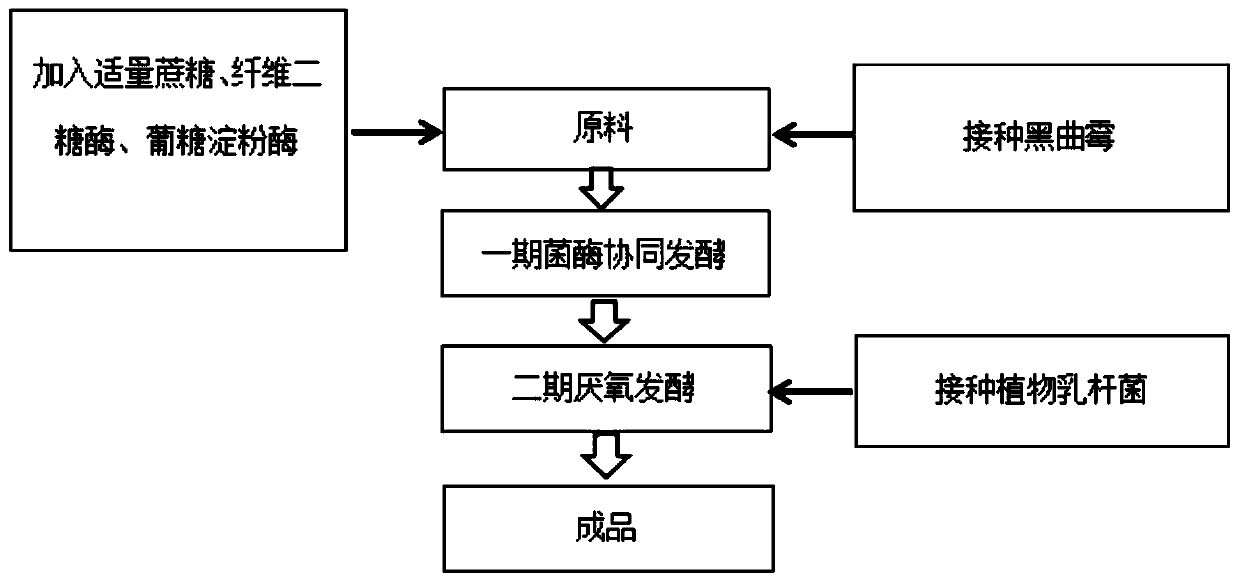Fermentation method for effectively improving content of soy isoflavone glycoside in soybean dreg feed
The technology of isoflavone aglycone and fermentation method is applied in the field of fermentation for effectively increasing the content of soybean isoflavone aglycone in bean dregs feed, which can solve the problems of harsh reaction conditions, incomplete fermentation, low conversion efficiency, etc. The method is simple and practical, and the effect is good
- Summary
- Abstract
- Description
- Claims
- Application Information
AI Technical Summary
Problems solved by technology
Method used
Image
Examples
Embodiment 1
[0033] (1) Activation culture of Lactobacillus plantarum:
[0034] A, first configure the culture medium of plantarum lactobacillus;
[0035] Slope and plate medium: 5g yeast extract, 10g sodium chloride, 10g peptone, 20g agar, 15g glucose, 1L distilled water, natural pH. Sterilize at 110°C for 30 minutes. The composition of the liquid seed medium is the same as that of the slant medium, the difference is that no agar is added;
[0036] B, the activation culture method of Lactobacillus plantarum:
[0037] Culture method: under sterile conditions, inoculate Lactobacillus plantarum stored at 4°C into the slant medium, culture at 30°C for 30 hours to recover the strains, then draw colonies on the plate, pick the seeds and inoculate them into 100mL liquid medium respectively. In shake flask (250mL), 150r / min, 30 ℃ cultivated 24h, obtain plantarum lactobacillus fermented seed liquid, inoculate in a large amount of liquid culture medium with 1% inoculum size and expand cultivatio...
Embodiment 2
[0042] (1) The activation culture of plantarum lactobacillus, concrete operation is with embodiment 1;
[0043] (2) Configure the first-stage solid fermentation basal medium, and the weight percentages of each component are respectively: 96.6% of bean dregs; 1.3% of sucrose; 0.8% of cellobiase; 1.3% of glucoamylase, and mix uniformly to obtain a good Oxygen fermentation medium;
[0044] (3) Aspergillus niger powder is added to the one-phase aerobic fermentation medium, the inoculum size is 0.02% of the one-phase aerobic fermentation medium weight, the water content of the adjustment medium is 32%, and the fermentation temperature is 32°C, preferably Oxygen fermentation 4h, after carrying out the first-stage aerobic fermentation, obtain the first-stage fermentation mixture;
[0045] (4) the one-stage fermented mixture that the plantarum fermented seed liquid obtained in inoculation step (1) obtains in step (3), the inoculum size is 17% of the one-stage fermented mixture weight...
Embodiment 3
[0047] (1) The activation culture of plantarum lactobacillus, concrete operation is with embodiment 1;
[0048] (2) Configure the first-stage solid fermentation basal medium, and the weight percentages of each component are respectively: 99.9% of bean dregs; 0.04% of sucrose; 0.02% of cellobiase; Oxygen fermentation medium;
[0049] (3) Aspergillus niger powder is added to the one-phase aerobic fermentation medium, the inoculum size is 3% of the one-phase aerobic fermentation medium weight, the water content of the adjustment medium is 70%, and the fermentation temperature is 22 ℃, preferably Oxygen fermentation 4h, after carrying out the first-stage aerobic fermentation, obtain the first-stage fermentation mixture;
[0050] (4) the one-stage fermented mixture that the plantarum fermented seed liquid obtained in inoculation step (1) obtains in step (3), the inoculum size is 17% of the one-stage fermented mixture weight, and the total number of viable bacteria is 0.5 × 10 9 c...
PUM
 Login to View More
Login to View More Abstract
Description
Claims
Application Information
 Login to View More
Login to View More - R&D
- Intellectual Property
- Life Sciences
- Materials
- Tech Scout
- Unparalleled Data Quality
- Higher Quality Content
- 60% Fewer Hallucinations
Browse by: Latest US Patents, China's latest patents, Technical Efficacy Thesaurus, Application Domain, Technology Topic, Popular Technical Reports.
© 2025 PatSnap. All rights reserved.Legal|Privacy policy|Modern Slavery Act Transparency Statement|Sitemap|About US| Contact US: help@patsnap.com


